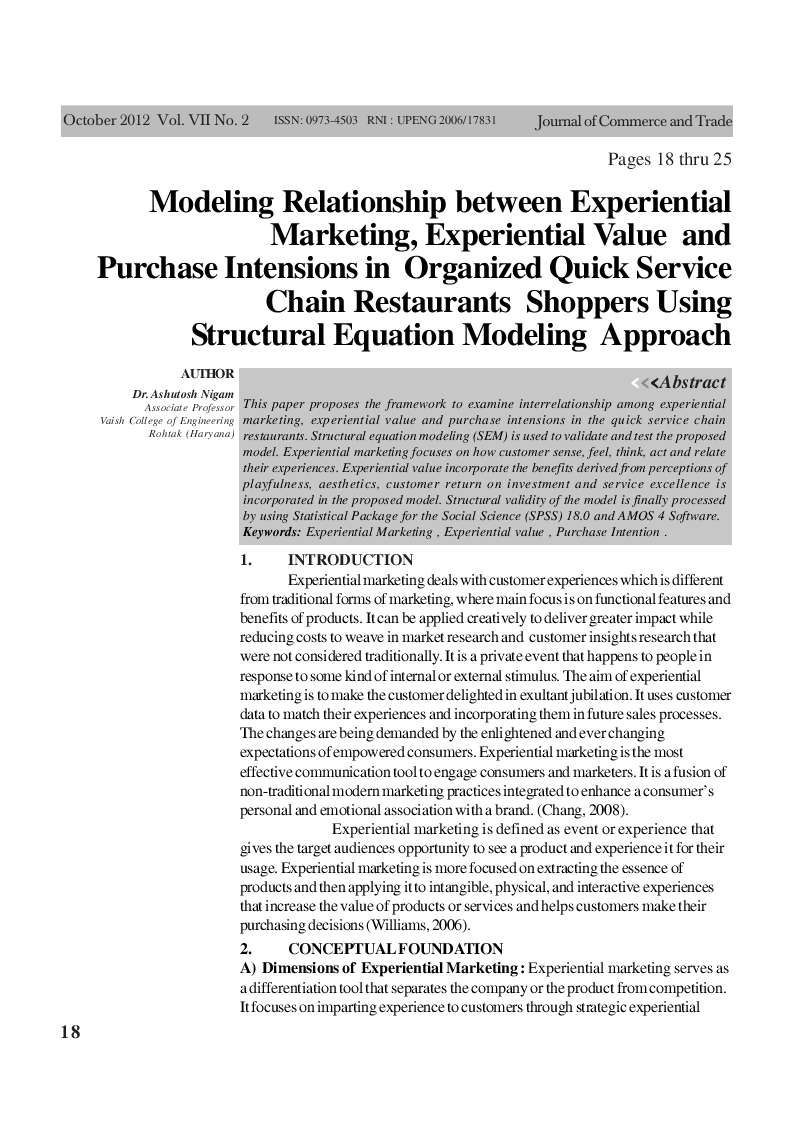Modeling Relationship between Experiential Marketing, Experiential Value and Purchase Intensions in Organized Quick Service Chain Restaurants Shoppers Using Structural Equation Modeling Approach
DOI:
https://doi.org/10.26703/jct.v7i2.296Keywords:
Experiential Marketing, Experiential Value, Purchase IntentionAbstract
This paper proposes the framework to examine interrelationship among experiential marketing, experiential value and purchase intensions in the quick service chain restaurants. Structural equation modeling (SEM) is used to validate and test the proposed model. Experiential marketing focuses on how customer sense, feel, think, act and relate their experiences. Experiential value incorporate the benefits derived from perceptions of playfulness, aesthetics, customer return on investment and service excellence is incorporated in the proposed model. Structural validity of the model is finally processed by using Statistical Package for the Social Science (SPSS) 18.0 and AMOS 4 Software.
Downloads
Metrics
References
Artur Baldauf, Karen S. Cravens, Gudrun Binder, (2003). Performance consequences of brand equity management: evidence from organizations in the value chain, Journal of Product and Brand Management, Vol. 12 No. 42003, pp. 220-236
Armstrong, R.W. and Tan Boon Seng. (2000), “Corporate-customer Satisfaction in the banking industry of Singapore”, International Journal of Bank Marketing, 18/3, 97 – 111.
Batra, R., & Ahtola, O. T. (1991). Measuring the hedonic and utilitarian sources of consumer attitudes. Marketing Letters, 2(2), 159-170.
Babin, Barry J., William R. Darden, and Mitch Grifn (1994). Work and/or Fun: Measuring Hedonic and Utilitarian Shopping Value. Journal of Consumer Research, 20(March), 644–656.
Bentler P. M. and Bonett D. G. (1980). “Significance tests and goodness of fit in the analysis of covariance structures,” Psychological Bulletin, 88, pp.588-606.
Bentler P. M. (1995). “EQS Structural Equations Program Manual.” Encino, CA: Multivariate Software.
Browne M. W. and Cudeck R. (1993). “Alternative Ways of Assessing Model Fit,” In Bollen K. A. and Long J. S. (Eds.), “Testing Structural Equation Models.” New-bury Park: Sage, pp.136-162.
Chang, H. H . (2008). “The impact of online store environment cues on purchase intention”. Online Information Review, 32
Connolly R. & Bannister. F. (2008). Factors influencing irish consumers trust in Internet Shopping”,Management Research News 31(5) ,339-358
Deighton, John and Kent Grayson (1995). Marketing and Seduction: Building Exchange Relationships by Managing Social Consensus. Journal of Consumer Research, 21(March), 660-676.
Donald G. Morrison(1979) ,” Purchase Intention and Purchase Behavoiur” Journal of Marketing Vol. 43, No. 2 (Spring, 1979), pp. 65-74.
Fornell C. and Larcker D. F. (1981) “Evaluating Structural Equation Models with Unobservable Measurement Errors,” Journal of Marketing Research, 18, pp.39- 50.
Mathwick C, Malhotra N. and Rigdon E (2001) ,” Experiential value : conceptualization measurement and Application in the catalog and Internet shopping environment”, Journal of Retailing, pp 39-56
Gronholdt L., Martensen A. and Kristensen K. (2000). “The Relationship between Customer Satisfaction and Loyalty: Cross-Industry Differences,” Total Quality Management, 11(4-6), pp.509-514.
Grundey D. (2008), “Experiential Marketing V/s Traditional Marketing : Creating Rational and Emotional Liasions with consumers” The Romanian Economic Journal, Year XI no 29, pp 133-151
Holbrook, Morris B. and Kim P. Corfman (1985). Quality and Value in the Consumption Experience: Phaedrus Rides Again, pp. 31-57 in Perceived Quality: How Consumers View Stores and Merchandise, Jacob Jacoby and Jerry C. Olson (Eds.), Lexington, MA: Lexington Books.
Holbrook M. B. (1994). The nature of customer value: An axiology of services in the consumption experience. In R. Rust, & R. L. Oliver (Eds.), Newbury park service quality: New directions in theory and practice, (pp. 21-27), Thousand Oaks, CA: Sage Publications.
Hair J. F., Anderson R., Tatham R. L. and Black W. C. (1998). “Multivariate Data Analysis (5th).” N. J.: Prentice Hall Inc.
Hu L. and Bentler P. M. (1999). “Cutoff Criteria for Fit Indexes in Covariance Structure Analysis: Conventional Criteria versus New Alternatives,” Structural Equation Modeling, 6(1), pp.1-55.
Mulaik S. A., James L. R., Van A. J., Bennett N., Lind S., and Stilwell C. D. (1989). “Evaluation of Goodness-of-Fit Indices for Structural Equation Models,” Psychological Bulletin, 105, pp.430-445.
McDonald R. P. and Ho M. R. (2002). “Principles and Practice in Reporting Structural WSEAS TRANSACTIONS on BUSINESS and ECONOMICS Hsien-Lun Wong, Mei-Chi Tsai ISSN: 1109-9526 67 Issue 2, Volume 7, April 2010 Equation Analysis,” Psychological Methods, 7, pp.64-82.
Nedungadi P.(1990),”Recall and Consumer Consideration Sets: Influencing Choice without Altering Brand Evaluation”, Journal of Consumer Research, pp 263-276.
Schmitt, B. H.(1999), “Experiential Marketing: How to Get Customers to Sense, Feel, Think, Act, Relate to Your Company and Brands,” Free Press, New York.
Veryzer, Robert W. Jr (1993)., “ Aesthetic Response and the Inuence of Design Principles on Product Preferences “ Advances in Consumer Research, 20, Association for Consumer Research. pp. 224–228
Williams, A. (2006). Tourism and hospitality marketing: Fantasy, feeling and fun. International Journal of Contemporary Hospitality Management, 18(6/7), 482-495.
Wong H. L., Shen T. Y., Yan C. Y. and Tsai M. C. (2009). “The Effects of Time-limited Pressure and Perceived Value on Consumers’ Intention to Purchase: A Study of Travel Fairs,” WSEAS Transactions on Business and Economics, 8(6), pp.446-455.
Zhou, L. (1996),”Brand familiarity and confidence as determinants of purchase intention in multibrand context”, Journal of Business Research,37(2), pp 115-120
Zeithaml, V.A., Berry, L.L., and Parasuraman, A. (1996), “The Behavioral Consequences of Service Quality,” Journal of Marketing. Vol. 60, 31-46.
Weblinks: http://mpra.ub.uni-muenchen.de/25638/1/Experiential_Marketing.PDF

Downloads
Published
How to Cite
Issue
Section
License
Copyright (c) 2012 Dr. Ashutosh Nigam

This work is licensed under a Creative Commons Attribution 4.0 International License.














